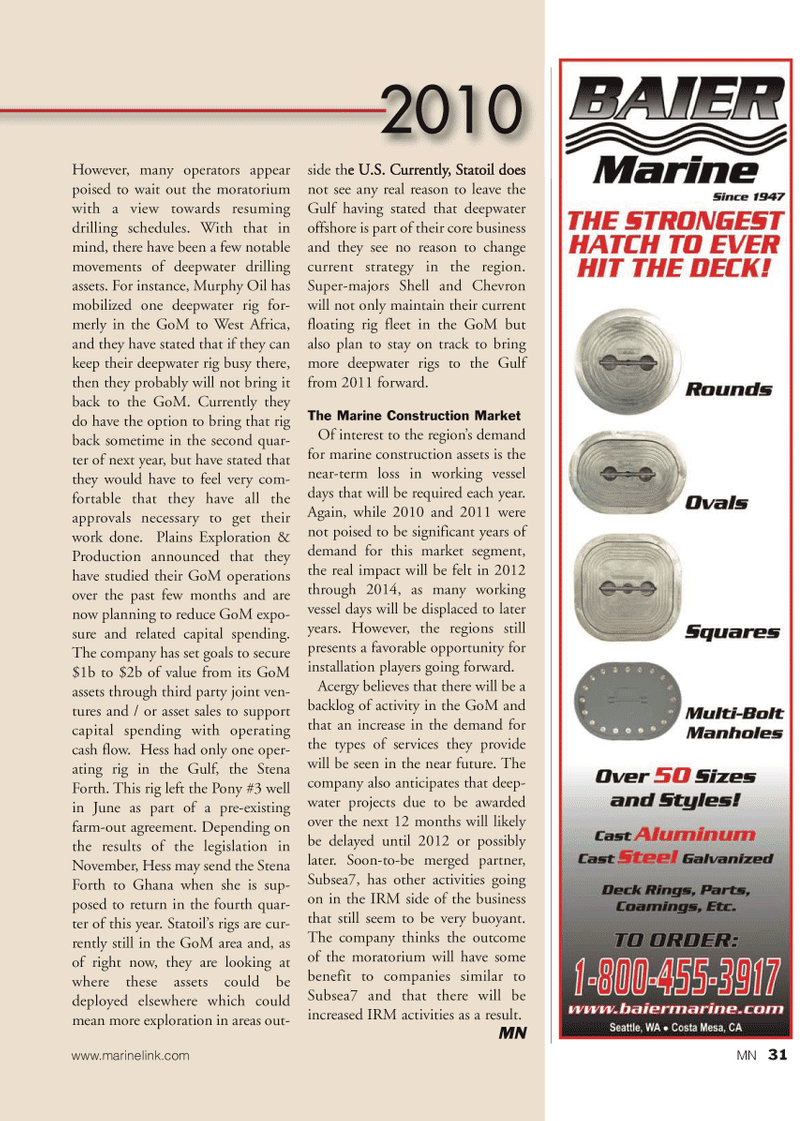
Page 31: of Marine News Magazine (October 2010)
Annual World Yearbook
Read this page in Pdf, Flash or Html5 edition of October 2010 Marine News Magazine
However, many operators appear poised to wait out the moratorium with a view towards resuming drilling schedules. With that in mind, there have been a few notable movements of deepwater drilling assets. For instance, Murphy Oil has mobilized one deepwater rig for- merly in the GoM to West Africa, and they have stated that if they can keep their deepwater rig busy there, then they probably will not bring it back to the GoM. Currently they do have the option to bring that rig back sometime in the second quar- ter of next year, but have stated that they would have to feel very com- fortable that they have all the approvals necessary to get their work done. Plains Exploration &
Production announced that they have studied their GoM operations over the past few months and are now planning to reduce GoM expo- sure and related capital spending.
The company has set goals to secure $1b to $2b of value from its GoM assets through third party joint ven- tures and / or asset sales to support capital spending with operating cash flow. Hess had only one oper- ating rig in the Gulf, the Stena
Forth. This rig left the Pony #3 well in June as part of a pre-existing farm-out agreement. Depending on the results of the legislation in
November, Hess may send the Stena
Forth to Ghana when she is sup- posed to return in the fourth quar- ter of this year. Statoil’s rigs are cur- rently still in the GoM area and, as of right now, they are looking at where these assets could be deployed elsewhere which could mean more exploration in areas out- side the U.S. Currently, Statoil does not see any real reason to leave the
Gulf having stated that deepwater offshore is part of their core business and they see no reason to change current strategy in the region.
Super-majors Shell and Chevron will not only maintain their current floating rig fleet in the GoM but also plan to stay on track to bring more deepwater rigs to the Gulf from 2011 forward.
The Marine Construction Market
Of interest to the region’s demand for marine construction assets is the near-term loss in working vessel days that will be required each year.
Again, while 2010 and 2011 were not poised to be significant years of demand for this market segment, the real impact will be felt in 2012 through 2014, as many working vessel days will be displaced to later years. However, the regions still presents a favorable opportunity for installation players going forward.
Acergy believes that there will be a backlog of activity in the GoM and that an increase in the demand for the types of services they provide will be seen in the near future. The company also anticipates that deep- water projects due to be awarded over the next 12 months will likely be delayed until 2012 or possibly later. Soon-to-be merged partner,
Subsea7, has other activities going on in the IRM side of the business that still seem to be very buoyant.
The company thinks the outcome of the moratorium will have some benefit to companies similar to
Subsea7 and that there will be increased IRM activities as a result.
MN 2010 www.marinelink.com MN 31

 30
30

 32
32
